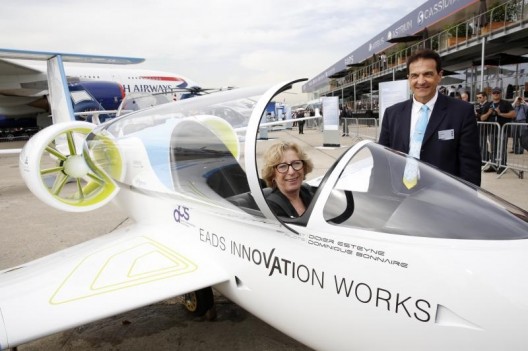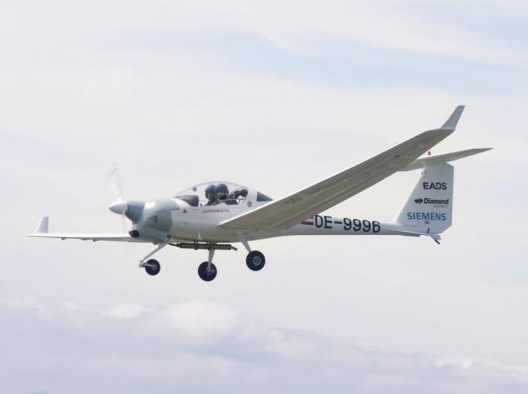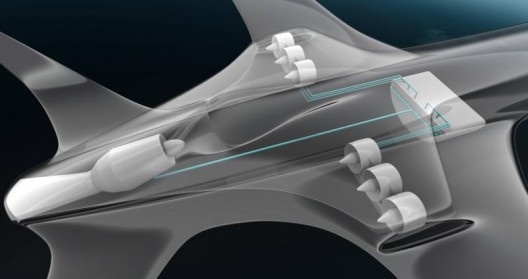EADS (European Aerospace Defense Systems), known colloquially as Airbus, highlighted its Paris Air Show chalet at Le Bourget with three examples of the work from its Innovations Workshops.
All projects are part of the European Commission’s “Flightpath 2050” initiative, conceived to reduce carbon dioxide (CO2) emissions 75 percent, nitrogen oxide (NOx) emissions 90 percent and noise 65 percent from 2000 levels by 2050.
EADS thinks electric and hybrid propulsion could become an alternative to fossil fuels within that timeline, with several projects highlighting, “the willingness of EADS to invest in technologies that today, tomorrow, will further reduce emissions of carbon dioxide from aviation.”
E-FAN
Working with Aero Composites Saintonge (ACS), the IW Research and Technology Group has developed and built the trainer all-electric “E-Fan” dedicated to general aviation. Created in only eight months, this jet-like machine makes use of sailplane design and ultralight-type composite construction to house its two electric motors and two 65-kilogram battery packs in its wings. Motors appear (in the video) to be similar to the Rotex units fitted to the Cri-Cri EADS present at the 2011 Paris Air Show.

Geneviève Fioraso Minister of Higher Education and Research (in cockpit) visits EADS at the Le Bourget Paris Air Show 2013, trying out the E-FAN EADS Innovation Works electric plane. EADS CTO Jean Botti explains the airplane’s highlights. Photo courtesy EADS | photographer Gilles Bassignac
Jean Botti, Chief Technology and Innovation Officer (CTO) of EADS explains, “The introduction of the electric aircraft E-Fan is a new strategic step in the EADS aerospace research. We are committed to exploring technologies that optimize the energy efficiency of our civil and military products.”
With its 6.7 meter (22 feet) long fuselage and 9.5 meter (31-feet, 2-inches) wingspan, E-FAN, according to EADS, “Is the first electric aircraft with ducted propellers to reduce noise and increase safety.” The E-FAN’s landing gear includes an electric drive that can taxi the airplane decoupled from the flight motors and even assist with takeoff, bringing the airplane up to 60 kilometers per hour (37.2 mph). An embedded optimized power management (e-FADEC) system provides automatic engine control and simplifies operation. “We believe that the E-FAN is an ideal platform which, once fully mature, will be certified and marketed as [an] ab initio flight school [trainer],” said Botti.
Two power systems – one 250 Volt and the other 24 Volt – power the flight motors and (in your editor’s guesstimate) the electric taxiing system.
Diamond Aircraft DA36 E-Star 2 Serial Hybrid Electric Aircraft
Alongside the development of the E-FAN, EADS is exploring hybrid systems, an IW Technology Team working with Siemens and others to refine the Diamond Aircraft DA36 “E-Star” airplane introduced at the 2011 Paris Air Show.

EADS E-Star in flight. This modified hybrid electric motor glider first made an appearance at the 2011 Paris Air Show. Photo courtesy EADS
The E-Star now has a lighter, more compact motor from Siemens, and total aircraft weight has been reduced 100 kilograms (220 pounds). A small Austro Engine Wankel rotary engine linked to a generator provides power to the battery packs in the wings. Compared to the E-FAN, it is a decidedly conventional airplane, and one which could provide good touring capabilities if the fuel economy possible with hybrid power can be realized.
Distributed Power
Another EADS IW has been working with Rolls-Royce in the DEAP (Distributed Electrical Aerospace Propulsion) project, funded by the UK Technology Strategy Board. This project developed the architecture of a distributed propulsion system meant to improve fuel efficiency and reduce emissions and noise. The architecture uses six power turbochargers connected in three clusters within a common intake conduit installed on the upper wing. A gas generator produces electric energy both for the motors and the reloading of the energy storage system.
http://www.youtube.com/watch?v=GlqX4m0R6E8
“The idea of distributed propulsion offers the opportunity to better optimize individual components such as the gas generator, which produces only electrical energy, and turbochargers power, which deliver thrust. This architecture optimizes the overall integration of the propulsion system,” said Sebastien Remy, head of EADS Innovation Works, who hopes the, “Optimized integration of such a concept will reduce the total weight and drag of the aircraft.”

E-Thrust conceptual view. E-Thrust is an electrical distributed propulsion system concept for lower fuel consumption, fewer emissions and less noise. Illustration courtesy EADS
E-Thrust would have a sophisticated superconducting power system at its core; a single large advanced gas turbine engine acting as a generator feeding a “next generation energy storage system” and six electrically-powered fans producing thrust. Flight profile management would use full thrust from the distributed electric fans for takeoff, draining the batteries somewhat even with the gas turbine recharging them. At cruise, batteries would accumulate energy and during descent/glides drain slightly. They would be recharged slowly during the descent/windmilling phase, with the airplane landing with fully energized batteries ready for the next flight.
The gas turbine consists of a “wake re-energizing fan,” with “structural stator vanes passing electrical current and cryogenic fluid coolant,” making it a “hub-mounted, totally superconducting electrical machine.”
Big or small, these EADS projects show an enthusiastic embrace of new technology, unfettered by conventional thought or constraints. Such innovations will certainly help achieve the goals of the Flightpath 2050 Initiative. Besides, your editor would love to train in an E-FAN as soon as possible.

Comments 1
While it is admirable that EADS is working on these ideas, projects like the E-Star show a stunning lack of originality. My team at Boeing worked with Christian Dries at Diamond back in 2006 to create a successful serial hybrid fuel cell electric testbed based on the same Dimona airframe. We flew it in 2008, and it now hangs from the ceiling of the Future of Flight in Everett, Washington. At least the E-Fan displays some original thinking.
(Editor’s Note: Michael Friend is Technology Director at Boeing.)